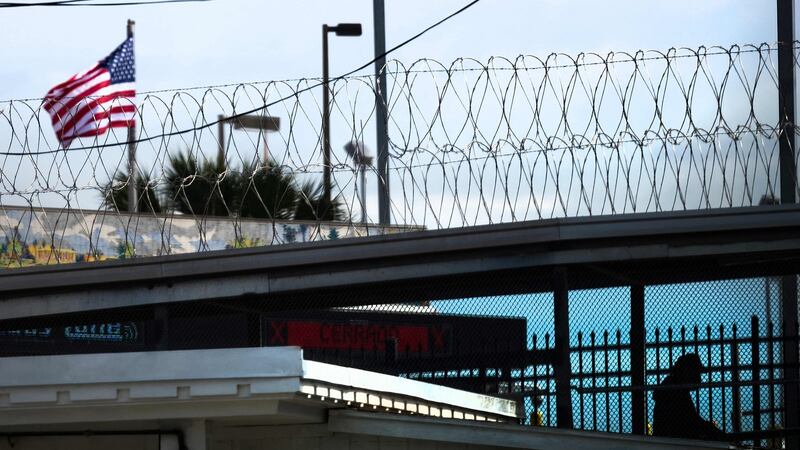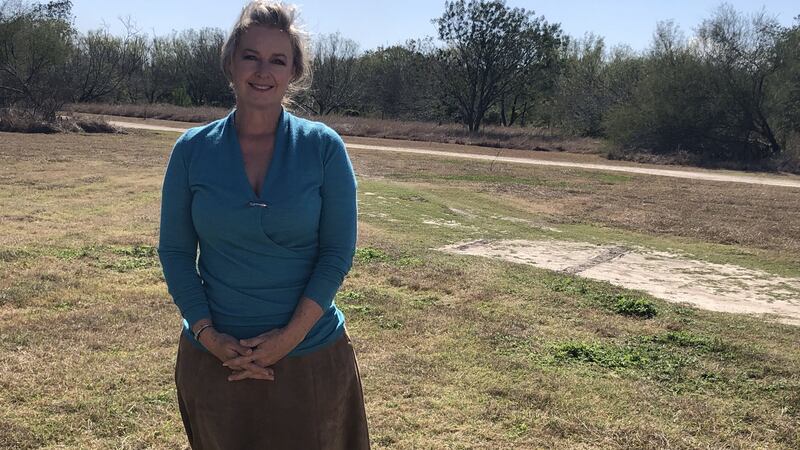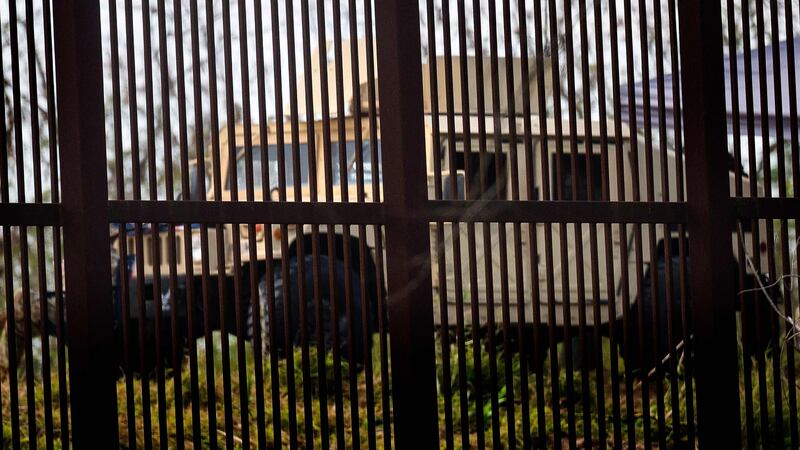On the banks of the Rio Grande, two American soldiers in green and brown fatigues stand guard in the afternoon sun.
Their four-wheel drive military vehicle, known as a Humvee, overlooks a slipway used by law-enforcement agencies to launch boats to patrol the river.
A couple of hundred metres across the water is Mexico. In the view of the American right, Mexico is the gateway for illegal immigrants to cross the border into the United States.
In the run-up to elections, both national and local, later this year, immigration is an especially hot issue.
Republicans contend that the administration of president Joe Biden has lost control of the US's southern border.
In Texas, Republican governor Greg Abbott has come under criticism from those on his right who claim he is not doing enough to prevent illegal immigrants crossing over from Mexico.
The soldiers at the Rio Grande are part of a Texas national guard unit dispatched by Abbott to the border as a show of force as much to his political critics locally as to the people-smuggling gangs.

However, the national guard is not the only agency in the vicinity charged with deterring illegal immigration.
There is a panoply of law enforcement bodies involved, including the border patrol, local police, Texas game wardens, homeland security personnel and immigration authorities, among others.
Border wall
To the rear of the national guard troops overlooking the river stands a segment of the controversial border wall, designed to block unauthorised entry from Mexico to the United States – a wall that has been under intermittent construction for about 25 years.
First commenced under Bill Clinton, intensified after the 9/11 attacks by George W Bush and famously championed by Donald Trump, the project is continuing under Biden.
The wall consists of bollards anchored in concrete panels with, in some places, metal plates on top – which together can reach more than seven metres in height.
In some instances the wall is not at the border itself, but a couple of kilometres inside US territory. At the segment where the national guard troops stand by their Humvee at the Rio Grande, the wall has actually cut off a retirement community who have to pass through it to go about their daily business.
About 40 hectares (100 acres) of land nearby, running down to the banks of the river, is owned by the US National Butterfly Center, a non-profit organisation dedicated to the study and conservation of wild butterflies in their natural habitats.
Marianna Trevino Wright, executive director of the centre, points to the security installations as she drives around the perimeter of the property.
Beside the gear-shift stick in her car is a loaded handgun. She believes it is necessary for security after the centre became the target of right-wing conspiracies online, which maintained that its environmental activities were a cover for something more sinister – people-smuggling, sex-trafficking and the abuse of children.

The centre is a botanical garden that, over its 20-year history, has propagated 300 species of native plants and where about 240 different types of butterflies have been spotted.
However, since late last month its doors have been closed to the public. The gate to the main road is locked and in the driveway stands a police guard tower with cameras on all sides.
Stirrings of trouble
The trouble for the centre began when it was slated to be on the route for the border wall under the first tranche of funding allocated by Congress to Trump for the project.
Trevino Wright says the centre objected after she found contractors in July 2017 clearing the ground on the property before even an opening letter had been received from the government about the wall.
This objection, she says, drew the attention and ire of groups supportive of the border wall. “It outraged those who want the border wall to run from sea to shining sea, and they did not seem to care much that the project was being executed illegally.”
"They claimed that I myself was selling women and children into sex slavery. All of these things provoked ire and led to threats and business disruption and really awful things"
It was widely reported in May 2019 that Jared Kushner, Trump's adviser and son in law, had said at a meeting at the White House attended by Republican senators that "we have solved the butterfly thing".
Trevino Wright said the centre had no idea what this comment meant.
Shortly afterwards, she says, an organisation known as We Build the Wall, which was seeking private funding to build part of the Mexican border barrier, and which was linked to former Trump strategist Steve Bannon, turned up in the locality "and literally took aim at us".
“They began declaring on social media they had posted snipers in our bushes and around our property. That there were dead bodies on our property; that we were running an illegal smuggling operation and that we were cartel operatives.
“They claimed that I myself was selling women and children into sex slavery.
“All of these things provoked ire and outraged and led to threats and business disruption and really awful things.”
Legal action for defamation is under way.
‘An altercation’
Trevino Wright says that, several weeks ago, a woman running for Congress in Virginia "showed up here and provoked an altercation".
She says the woman was “reiterating all false statement that We Build the Wall had made against us”.
Trevino Wright believes the butterfly centre is being used as a prop in a broader political campaign. She says political operatives show up at the property “filming propaganda videos and spreading lies that they are advancing online in their media channels and chats”.
“They are basically using us as a backdrop, and we are honestly the perfect setting for that – for the marriage of two terrible fairy tales – Grimm brothers epic-level fairy tales – about the bad hombres they claim are pouring across Biden’s open border, which does not exist, and paedophilia or child sex trafficking.”
Trevino Wright says she is fearful that someone could arrive at the butterfly centre with guns and put her staff at risk.“These are the very same people who stormed the US Capitol on January 6th. People who took the stage to incite the violence have come to make videos outside the butterfly centre.”

The board of the centre is talking with private security firms about measures that could be taken to allow it to reopen.
Asked if the centre will ever be the same again, Trevino Wright’s eyes fill with tears. “It will be different in the future ... It has been hard to go through the experiences we have gone through over the last few years and the threats we have [experienced], and not be aware that you are walking around with a target on your back.”
Just outside the property, Trevino Wright points to sections of the border wall built under Trump and a section – slightly smaller in height – which she says was constructed under the Biden administration.
The federal government maintains this portion is work being undertaken to upgrade the levee system that protects residents in the Rio Grande valley from flooding from the river.
Immigration activists, however, contend the work is really the continuation of Trump’s border wall.
‘Great unifier’
At the University of Texas in Austin, Dr Jim Henson of the Texas Politics Project and the department of government describes the twin issues of immigration and border security as the "great unifier" among Republicans in the state.
“Immigration is highly salient among Republicans. They tend to favour stricter border enforcement, lower levels of legal and illegal immigration and support even the state paying for a wall.
“When we asked over the last dozen years of polling what is the most important problem facing the state of Texas, among Republicans, immigration and border security is routinely the response of above half.”
Henson says that as part of Texas governor Abbot’s preparations for the 2022 primary elections, the budget for overall spending on border security in the state almost tripled, from $1 billion to close to $3 billion.
However, he says more than half of Texans maintain that is still not enough.
The grassroots conservative group True Texas Project is critical of the governor's actions in securing the border.
"Half of this problem is on Mexico's shoulders, and Mexico does not seem to have any incentive to do anything to help stop it"
The group's president, Fran Rhodes, says: "We believe the governor has the authority under the constitution to control that border, and although the governor talks about it a lot and the legislature has allocated a lot of money to it and we have sent national guard troops down there, none of it is working.
“There are still thousands and thousands and thousands of illegals coming across that border every day. And we feel like there is a way to [stop that], and governor Abbot has not had to the courage to actually defy the federal government and go do it.”
Rhodes says she does not have the specific answers as to what should be done at the border. However, she says “people who are smarter than me do [have answers] and one thing that has been suggested is to close down all the bridges and stop commerce in order to force the Mexican side to do something about it.
“Half of this problem is on Mexico’s shoulders, and Mexico does not seem to have any incentive to do anything to help stop it,” says Rhodes.












